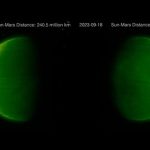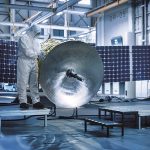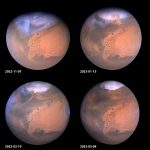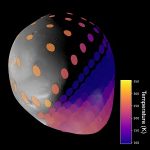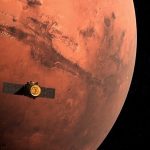The observations of a new type of Martian aurora by Emirates Mars Missions Hope probe will open up new areas for investigating Mars' highly dynamic plasma environment.
 Emirates Mars Mission, the first interplanetary exploration undertaken by an Arab nation, has released new images of Mars enigmatic discrete auroras, following a new series of revolutionary observations, about the interactions between Mars atmosphere, the planets magnetic fields and the solar wind.
Emirates Mars Mission, the first interplanetary exploration undertaken by an Arab nation, has released new images of Mars enigmatic discrete auroras, following a new series of revolutionary observations, about the interactions between Mars atmosphere, the planets magnetic fields and the solar wind.
The observations include a never-before-seen phenomenon, dubbed the sinuous discrete aurora by the EMM team, a huge worm-like aurora that extends halfway around the planet.
Commenting on the development, Hessa Al Matroushi, Emirates Mars Mission Science Lead, said: “When we first imaged Mars discrete aurora shortly after the Hope probes arrival at Mars in 2021, we knew we had unveiled new potential to make observations never before possible on this scale, and we took the decision to increase our focus on these auroras. We can obtain nearly whole-disk, synoptic snapshots of the atmosphere to investigate atmospheric phenomena and interactions. It means we are seeing discrete auroral effects on a massive scale and in ways we never anticipated.”
The sinuous discrete aurora consists of long worm-like streaks of energised electron emission in the upper atmosphere extending many thousands of kilometres, stretching from the dayside into the nightside of Mars. Imaged when Mars was experiencing the effect of a solar storm, resulting in a faster, more turbulent stream of solar wind electrons than usual, these aurora observations are some of the brightest and most extensive yet seen by Hope. They include elongated shapes, which may be caused by similarly elongated regions of electron energization conditions in the magnetotail.
The interplanetary magnetic field is carried by the solar wind and drapes around Mars, combining with magnetism in the Martian crust to form Mars magnetotail, a complex array of magnetic fields on the Martian nightside.
Omran Sharaf, EMM Project Director, added: “Having additional bandwidth and resources available to us meant we could be opportunistic and focus more on the area of discrete auroras than we had originally planned. That agility has certainly paid off as we have now opened up whole new avenues of investigation into these transient and dynamic phenomena. Novel science was a core mission objective and this is certainly novel.
Observations made using Hopes EMUS (The Emirates Mars Ultraviolet Spectrometer) instrument range between 90-180 nanometre wavelengths. Found at a wavelength of 130.4 nm, the UV emissions imaged in the new set of observations show where energetic electrons are smashing into atoms and molecules in the Martian upper atmosphere, some 130 km above the planetary surface. These electrons come from the solar wind and are energized by electric fields in Mars magnetosphere.
Dr Rob Lillis, EMUS team member at the University of California, Berkeley, stated: “The sinuous discrete aurora was a shocking discovery that in many ways has us scratching our heads and going back to the drawing board. We have ideas but no solid explanation for why we are observing intense aurora of this shape and at planetary scales. We now have the opportunity to re-examine prior observations of Mars by missions such as MAVEN and Mars Express to search for signatures that could flesh out Hopes new observations and perhaps help us try and unpick quite what is happening here.
Electrons follow magnetic field lines, so their paths to the atmosphere are determined by the magnetic fields in this environment. The new observations made by Hope include draped field lines, which dont touch the nightside atmosphere, closed field lines which connect to the crust at both ends, and open field lines which connect the crust to the solar wind. These open field lines funnel electrons toward the atmosphere in sometimes intricate patterns, which are then reflected in the resulting UV emission detected by EMUS. Because they are spatially confined, these emissions are known as discrete auroras.
Alongside auroras defined by Mars crustal field, the complex shapes of energised electron impact observed by Hope open up new avenues for our understanding of how the combination of planetary and solar interactions impact Mars atmospheric dynamics.
Three types of aurora have previously been observed around Mars: the diffuse aurora is observed only during intense solar storms, when interactions with the highest energy particles cause the atmosphere around the entire planet to light up. In contrast, the discrete aurora is highly localised and observations made to date have appeared to bear out the theory that it is directly linked to the patchy magnetic fields produced by magnetised minerals embedded in Mars crust. Both of these aurorae are observed on Mars nightside, while a third class, the proton aurora, has been measured on Mars dayside and is driven by interactions between the solar wind and hydrogen in Mars exosphere.
These three types of aurora had previously been identified, but clear global images of the discrete aurora were elusive until new observations were made by EMMs probe shortly after its arrival on Mars. Now, an increased focus on discrete aurora observations by the EMM science team has resulted in observations of this new phenomenon of sinuous discrete aurora. Since those first observations of the discrete aurora, we have continued to see incredible new patterns of aurora that open new insights into the interactions of charged particles in the Martian atmosphere, added Al Matroushi. There is a very great deal of new information here for the EMM science team to unpick.
One of three instruments on board Mars Hope Probe, EMUS principal science goal is the measurement of oxygen and carbon monoxide in Mars thermosphere and the variability of hydrogen and oxygen in the exosphere.







































































